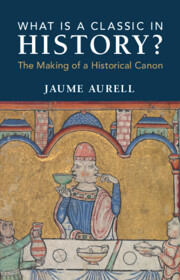Book contents
- What Is a Classic in History?
- What Is a Classic in History?
- Copyright page
- Contents
- Acknowledgements
- Introduction
- 1 The Conditions for Durability
- 2 The Dynamics of the Classic
- 3 The Inescapability of the Canon
- 4 The Canonical Function of Historical Genres
- 5 Genealogy as Double Agent
- Conclusions
- Selected Bibliography
- Index
3 - The Inescapability of the Canon
Published online by Cambridge University Press: 15 February 2024
- What Is a Classic in History?
- What Is a Classic in History?
- Copyright page
- Contents
- Acknowledgements
- Introduction
- 1 The Conditions for Durability
- 2 The Dynamics of the Classic
- 3 The Inescapability of the Canon
- 4 The Canonical Function of Historical Genres
- 5 Genealogy as Double Agent
- Conclusions
- Selected Bibliography
- Index
Summary
Arguing its relevance in historiography, and its connection with the related concept of the classic, this chapter examines the place of the canon in history: its formation, key turning points, convenience, usefulness, and the desirability of its existence itself. In the first part of the chapter (‘Constructions’), I examine the five main turning points in the formation of the canon in history: Greco-Roman, Collingwood-Croce, narrative history of the 1970s, gender and postcolonial, and global canon. The second part of the chapter (‘Canonizing’) examines three case studies of the canon in history: Gibbon’s Decline and Fall of the Roman Empire, Macaulay’s History of England and White’s Metahistory. The third part (‘Resistances’) explores the rejection of the canon among historians, describes some of its manifestations and reflects on its motivations. The fourth part (‘Paradoxes’) details the main characteristics of the historical canon, points out the differences among other canons such as the literary and artistic, and explores the peculiar combination of art and science that every historical operation entails. The conclusive section (‘Inescapability’) argues for the great paradox of the canon: the impossibility of conducting cultural and intellectual exchanges without it.
Keywords
- Type
- Chapter
- Information
- What Is a Classic in History?The Making of a Historical Canon, pp. 138 - 205Publisher: Cambridge University PressPrint publication year: 2024



